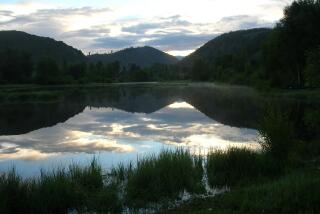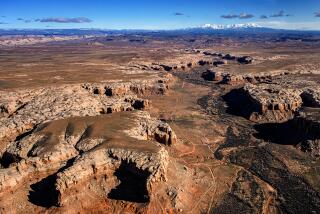COLUMN ONE : Prospering Again on the Prairie : A good many small towns in the Great Plains have made a quiet comeback. Active leaders and a sense of self-reliance keep them strong as other communities wither.
- Share via
WRAY, Colo. — Among the eulogies heard these days for the small towns of the Great Plains, one might expect to find the name of Wray. “I wonder why this place died?” a passer-by might ask, and the answer would come in the wind and the dust and the silence of the prairies.
In fact, the town nearly did die in 1971, struck by a tornado that flattened almost everything in sight. But Dale and Eunice Wisdom opened the doors of their lumberyard and told people, “Just take what you need. You can figure out what you owe us later.” The Red Cross came to provide disaster relief, and the mayor said, “Thanks, but we can handle this ourselves.” School was canceled in the neighboring communities and the kids were bused into Wray to sweep up the streets.
Six months later Wray had been rebuilt. The Wisdoms took inventory and found only two sheets of plywood unaccounted for. “Somebody’ll be along to pay for them,” Dale Wisdom said.
The same attitude that got the town through that calamity helped it survive the agricultural crisis of the 1980s. And in surviving, Wray may hold some lessons for the other troubled towns of the Great Plains.
Wray straddles Highway 34 near the Nebraska border, hardly more than a speck of a place: one main street, a couple thousand residents, a motel, all anchored by a cluster of grain elevators at the doorstep of town. Dozens of prairie communities not much different from Wray have emptied and been boarded up in recent years and the wind that rushes through their deserted streets is a reminder of the rural exodus that saw 1.1 million Americans nationwide leave their farms in the 1980s alone.
In the last 50 years, the share of Americans who earn their livelihoods on farms has dropped from 40% to 2%. On the Great Plains--the vast expanse reaching across 10 states, from the Rocky Mountains to the 98th meridian running through the Dakotas, and encompassing one-fifth of the United States’ continental land mass--the population of many counties has been declining since the 1890s. Today the Plains hold only 3% of the nation’s people--and account for one-third of its agricultural products.
The wind is the life blood of these way-station communities. It guides the storm clouds, creates the dust bowls, heralds the bone-chilling cold of winter and withering heat of summer--”Our weather keeps out the riffraff,” says one Plainsman--and because of it and the vicissitudes of life in the American outback, towns such as Wray have always been at peril, their existences measured in generations, and sometimes even in seasons.
The death knell that some alarmists have sounded for the Great Plains has been accompanied by many remedies. One group proposes triage, with states helping only those towns likely to survive while letting the others die. Another, in Montana, says moribund regions should be turned into a giant hunting preserve and dude ranch known as the Big Open. A University of Oklahoma geographer suggests that the Forest Service start buying out marginal farmers. And two New Jersey academics propose letting the Plains revert to their natural state, a sort of national park they would call the Buffalo Commons.
Yet largely ignored in the gush of distressing reports on the Plains is the fact that Wray--and a good many other little towns from Broken Bow, Neb., to Linton, N.D.--have turned the corner and are prospering. Their populations have stabilized, their business communities are healthy, their medical facilities and social amenities are blue-ribbon.
If they share a common denominator, say rural planners studying the Plains, it is the presence of strong community leadership willing to act independently of state and federal governments. Much of the leadership is voluntary and many of the mayors and council members are unpaid.
“Caring is the difference that’s kept us alive, I guess,” said Gene Granwell, the motel owner in Wray, whose 48-page phone book covers 10 communities. “We never stopped caring about ourselves, about each other. People need each other on the Plains.”
The driving force behind Wray’s revival is a 40-year-old former college wrestler, Mike Wisdom, Wray-born and the son of the lumberyard owners. On the wall above his desk he has tacked a quotation from Albert Einstein: “Great spirits always encountered violent opposition from mediocre minds.”
Wisdom’s makeshift office is at the top of Main Street and nearing completion just outside his window is the rehabilitation (for the elderly) and recreation (for the young) center that Wray had dreamed of for a generation. The project cost $2.3 million, or $1,000 for every man, woman and child in town. Over six years the citizens raised every penny themselves, from bake sales, by recycling aluminum cans (that provides a steady $36 a month), through countless little fund-raisers.
For $20, scores of people around the country became honorary mayor for a day. Donate $1,000 and you get a lifetime locker in the center. An annual lottery-style race of plastic ducks on the downtown Republican River to celebrate the end of harvest each year produced thousands more dollars.
Instead of hiring a professional grant writer, Wisdom and his friends figured out how to write their own and gained financial backing from Western foundations. Instead of fining youths for minor infractions of the law, the local judge sentenced offenders to 40 hours of community service helping build the center.
“No man should take more out of a community than he is prepared to give back,” said Wisdom, who works full time overseeing construction and, unbeknownst to his fellow townspeople, turns most of his modest salary back to the center each month.
“We’re paying for the center a square foot at a time and when the doors open, it’s going to be clear and paid for.” he said.
Across the Plains, other towns also are removing themselves from the endangered list. A decade ago most thought their future depended on attracting clean, light industries, but today their emphasis is on rescuing the local business community and improving the rural amenities, services and infrastructure that the farms need to survive.
Without healthy towns, planners say, the break-up of small farms and the population drift toward urban centers will continue.
“We all know why towns die,” said Vicki Luther, co-founder of the Heartland Center for Leadership Development in Lincoln, Neb. “Now what we need to study and analyze is what enables some towns to succeed and prosper.” In Nebraska, Luther found that the town of Ellsworth (population 27) was saved by one family that started a mail-order business now employing 65 people. In Cheney, Kan., a farmer’s wife set up a center that cares for 91 children, enabling parents to commute to jobs in Wichita. Seven farmers in Rosholt, S.D., bought the bankrupt farm implement dealership to keep it open, and residents in Cody, Neb., raised money to reopen the movie theater by staging a three-act play. Broken Bow, Neb., where 26 businesses closed in the ‘80s, is renovating downtown with a 1% tax it established, and Linton, N.D. remodeled an abandoned implement dealership into a telecommunications office that now employs 100 people.
The Great Plains have been in evolution since 1862 when the first in a series of homestead acts attracted the vanguard of millions of settlers. Towns were born, lost their usefulness and died, though the region’s economic importance remained undiminished. If the Great Plains today were a separate nation, it would be the world’s fourth-largest wheat producer and sixth-largest oil producer and would have a gross national product of $146 billion.
“To say the Great Plains are going down the tubes is pure bull,” said Philip Burgess, president of the Center for the New West, a Denver-based research institute. “What’s going on there is a lot of economic churning and change, just like in the rest of the world. The Soviet Union calls it perestroika and we celebrate it. The same thing happens in this country and we say it’s a problem.”
What Burgess sees emerging is an “archipelago society”--urban islands, linked by interstate highways and airports, in a sea of wheat. Within this area, economic units consolidate, some fragile towns die, economies become more diverse and the relationship between heartland and city becomes more national than regional.
Sioux Falls, S.D., for instance, is the site of a major credit card clearing house and now finds itself linked more to New York City than to Bismarck, N.D., or Billings, Mont. Marriott has its worldwide hotel reservations center in Omaha, and Kansas City is the largest assembler of automobiles outside of Detroit. Nearly one-quarter of North Dakotans are employed in businesses that did not exist in 1980. Less than 4% of those business are in agriculture.
Though two-thirds of the nation’s 19,252 cities and towns have populations less than 2,500, many rural Westerners believe the survival of small-town America has never been a high national priority. Said Burgess: “Our notion has always been that if New York City has a problem, we have to bail them out. But if there’s a problem on the Plains, our first reaction is to just stick it to the people.”
A visitor in Wray the other day asked Mike Wisdom about that attitude.
No matter, he said, “we take care of ourselves out here.” He mentioned Ollie Wood, the local seamstress, who every month, year after year, managed to save and invest $40. When she died she left $429,000 to the hospital and another $100,000 to establish a scholarship. And he mentioned the 1,000 people who were expected to show up for Wray’s alumni weekend following the high school graduation.
He started to tell another story, too, but before he could finish the fire whistle blew. He and the carpenter and the painter rushed out of the construction site. There was a brush fire at the edge of town and Wray’s volunteer fire department had work to do.
The Great Plains
The dry grasslands of the Great Plains cover about one-fifth of the United States, across a 400-mile-wide band, which drops at a rate of about 10 feet per mile from the Front Range of the Rockies to the Central Lowlands on the east. Today the Plains comprise only 3% of the nation’s people but produce one-third of its agricultural products.
More to Read
Sign up for Essential California
The most important California stories and recommendations in your inbox every morning.
You may occasionally receive promotional content from the Los Angeles Times.













